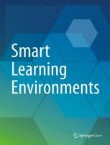Smart Learning Environments is affiliated with the International Association of Smart Learning Environments. This journal is supported by National Engineering Laboratory for Cyberlearning and Intelligent Technology and Smart Learning Institute of Beijing Normal University.
Exploring knowledge graphs for the identification of concept prerequisites
Learning basic concepts before complex ones is a natural form of learning. Automated systems and instructional designers evaluate and order concepts’ complexity to successfully generate and recommend or adapt ...
